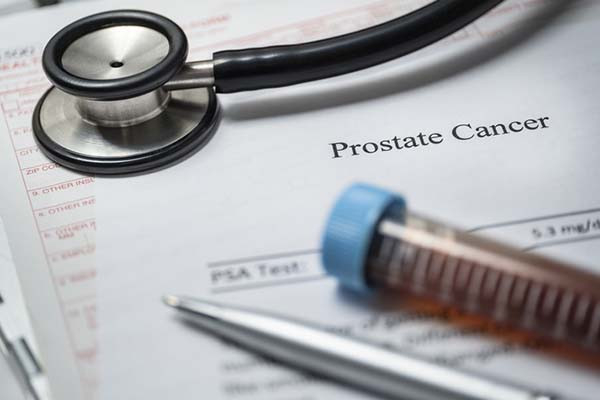
New research shows little risk of infection from prostate biopsies

Infections after a prostate biopsy are rare, but they do occur. Now research shows that fewer than 2% of men develop confirmed infections after prostate biopsy, regardless of the technique used.
In the United States, doctors usually thread a biopsy needle through the rectum and then into the prostate gland while watching their progress on an ultrasound machine. This is called a transrectal ultrasound-guided biopsy (TRUS). Since the biopsy needle passes through the rectum, there's a chance that fecal bacteria will be introduced into the prostate or escape into the bloodstream. For that reason, doctors typically treat a patient with antibiotics before initiating the procedure.
Alternatively, the biopsy needle can be passed through the peritoneum, which is a patch of skin between the anus and the base of the scrotum. These transperitoneal prostate (TP) biopsies, as they are called, are also performed with ultrasound guidance, and since they bypass the rectum, antibiotics typically aren't required. In that way, TP biopsies help to keep antibiotic resistance at bay, and European medical guidelines strongly favor this approach, citing a lower risk of infection.
Study goals and methodology
TP biopsies aren't widely adopted in the United States, in part because doctors lack familiarity with the method and need further training to perform it. The technology is steadily improving, and TP biopsies are increasingly being conducted in office settings around the country. But questions remain about how TRUS and TP biopsies compare in terms of their infectious complications.
To investigate, researchers at Albany Medical Center in New York conducted the first-ever randomized clinical trial comparing infection risks associated with either method. The results were published in February in the Journal of Urology.
The Albany team randomized 718 men to either a TRUS or TP biopsy. Nearly all the men who got a TRUS biopsy (and with few exceptions, none of the TP-treated men) first received a single-day course of antibiotics. All the biopsies were administered between 2019 and 2022 by three urologists working at the Medical Center's affiliated and nonaffiliated hospitals.
The men were then monitored for fever, genitourinary infections, antibiotic prescriptions for suspected or confirmed infections, sepsis, and infection-related contacts with caregivers. Researchers collected data during a visit conducted two weeks after a biopsy procedure, and then by phone over an additional 30-day period following this initial meeting.
What the researchers found
According to the results, 1.1% of men in the TRUS group and 1.4% of men in the transperineal group wound up with confirmed infections. The difference was not statistically significant. If "possible" infections were counted (for example, antibiotic prescriptions for fever), then the rates increased to 2.6% and 2.7% of men in the TRUS and TP groups, respectively.
Fever was the most frequent complication, reported by six participants in each group. One participant from each group also developed noninfectious urinary retention, requiring the temporary use of a catheter. None of the men developed sepsis or required post-biopsy treatments for bleeding.
The study had some limitations: Nearly all the participants were white, and so the results may not be applicable to men from other racial and ethnic groups. Furthermore, since all the men were biopsied by a single institution, it's unclear if the findings are generalizable in other settings. Still, the study provides reassuring evidence that both types of biopsies "appear safe and viable options for clinical practice," the authors concluded.
Commentary from experts
"The paper provides needed evidence that TP biopsies without antibiotics are about as safe and efficacious as TRUS biopsies with antibiotics," said Dr. Marc Garnick, the Gorman Brothers Professor of Medicine at Harvard Medical School and Beth Israel Deaconess Medical Center. The findings also help to dispel a growing view that transperineal biopsies are superior, Dr. Garnick pointed out.
"Recent years have witnessed a marked interest and surge in the transperineal approach, primarily driven by early studies suggesting a lower risk of infectious complications compared with transrectal biopsy," said Dr. Boris Gershman, a urologist at Harvard-affiliated Beth Israel Deaconess Medical Center in Boston, and a member of Harvard Health Publishing's Annual Report on Prostate Diseases advisory board.
"Interestingly, the investigators find no difference in infectious complications, and it will be important to see if other ongoing studies report similar results," Dr. Gershman continued. "In addition to safety, we also need to confirm whether there are any meaningful differences between the two approaches with respect to cancer detection rates."
About the Author

Charlie Schmidt, Editor, Harvard Medical School Annual Report on Prostate Diseases
Charlie Schmidt is an award-winning freelance science writer based in Portland, Maine. In addition to writing for Harvard Health Publishing, Charlie has written for Science magazine, the Journal of the National Cancer Institute, Environmental Health Perspectives, … See Full Bio View all posts by Charlie Schmidt
About the Reviewer

Marc B. Garnick, MD, Editor in Chief, Harvard Medical School Annual Report on Prostate Diseases; Editorial Advisory Board Member, Harvard Health Publishing
Dr. Marc B. Garnick is an internationally renowned expert in medical oncology and urologic cancer. A clinical professor of medicine at Harvard Medical School, he also maintains an active clinical practice at Beth Israel Deaconess Medical … See Full Bio View all posts by Marc B. Garnick, MD

Do children get migraine headaches? What parents need to know

Headaches are very common in children and teens. In fact, more than half will suffer from headaches at some point, and by 18 years the majority of adolescents have had them. And while most headaches are part of a viral illness, some are migraines. In fact, recurring migraines affect as many as one in 10 children and teens overall.
What should you know — and do — if you think your child or teen may be having migraines?
How early do migraines start to occur?
We don’t tend to think about migraines in children, but by age 10, one in 20 children has had a migraine. And migraines sometimes occur even earlier.
Before puberty, boys and girls are equally likely to have them. After puberty, migraines are more common in girls.
Which migraine symptoms are most common in children?
Migraines are often one-sided in adults. In children they are more likely to be felt on both sides of the head, either in both temples or both sides of the forehead.
While it’s not always easy to tell a migraine from another kind of headache, children
- often report throbbing pain
- may experience nausea and sensitivity to light and noise.
The flashing lights and other vision changes people often see as a migraine begins are less common in children. However, parents may notice that their child is more tired, irritable, or pale before a migraine begins — and takes a while to get back to normal after it ends.
What causes migraines in children?
We don’t know exactly what causes migraines. We used to think it had to do with blood flow to the brain, but that does not seem to be the case. It appears that migraines are caused by the nerves being more sensitive, and more reactive to stimulation. That stimulation could be stress, fatigue, hunger, almost anything.
Migraines run in families. In fact, most migraine sufferers have someone in the family who gets migraines too.
Can migraines be prevented?
The best way to prevent migraines is to identify and avoid triggers. The triggers are different in each person, which is why it’s a good idea to keep a headache diary.
When your child gets a headache, write down what was happening before the headache, how badly it hurt and where, what helped, and anything else about it you can think of. This helps you and your doctor see patterns that can help you understand your child’s particular triggers.
It’s a good idea to make sure your child gets enough sleep, eats regularly and healthfully, drinks water regularly, gets exercise, and manages stress. Doing this not only helps prevent migraines, but is also good for overall health!
How can you help your child ease a migraine?
When a migraine strikes, sometimes just lying down in a dark, quiet room with a cool cloth on the forehead is enough. If it’s not, ibuprofen or acetaminophen can be helpful; your doctor can tell you the best dose for your child.
It’s important not to give your child these medications more than about 14 days a month, as giving them more often can lead to rebound headaches and make everything worse!
Are there prescription medicines that can help children with migraines?
If those approaches aren’t enough, a class of medications called triptans can be helpful in stopping migraines in children ages 6 and up.
If a child experiences frequent or severe migraines, leading to missed days of school or otherwise interfering with life, doctors often use medications to prevent migraines. There are a number of different kinds, and your doctor can advise you on what would be best for your child.
Some girls get migraines around the time of their period. If that happens frequently, sometimes taking a prevention medicine around the time of menses each month can be helpful.
When to contact your doctor
If you think your child might be having migraines, you should call and make an appointment. Bring the headache diary with you. Your doctor will ask a bunch of questions, do a physical examination, and make a diagnosis. Together you can come up with the best plan for your child.
You should always call your doctor, or go to an emergency room, if your child has a severe headache, a stiff neck, trouble with coordination or movement, is abnormally sleepy, or isn’t talking or behaving normally.
The American Academy of Pediatrics has additional useful information about migraines, and how to treat and prevent them, on their website.
About the Author

Claire McCarthy, MD, Senior Faculty Editor, Harvard Health Publishing
Claire McCarthy, MD, is a primary care pediatrician at Boston Children’s Hospital, and an assistant professor of pediatrics at Harvard Medical School. In addition to being a senior faculty editor for Harvard Health Publishing, Dr. McCarthy … See Full Bio View all posts by Claire McCarthy, MD